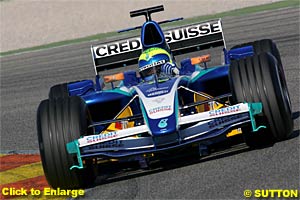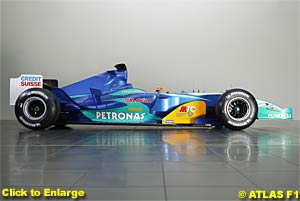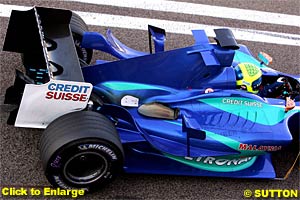
Atlas F1 Technical Writer
After nearly a full year working with their state-of-the-art wind tunnel, the Sauber team are ready to take another step towards the front with their new C24 car. Atlas F1's Craig Scarborough offers a full analysis of the changes and features found on the new car from the Swiss squad
Sauber launched their 2004 car amid a hail of controversy surrounding its design similarities to the previous year's Ferrari; the team maintained the design was all their own work, developed in the aging Emmen windtunnel in Switzerland, some distance from the team's factory. The car's lack of rear downforce and pace in the early races supported their claim. Soon the team's new tunnel was up and running, with the Silverstone race debuting dramatically shrunken rear bodywork; this cured the downforce issues and allowed the team to maximise their use of the Bridgestone tyres. By season's end their pace was pressing most of the midfield and top four teams.
Over the latter part of the season development on the new car went ahead in the new windtunnel, and the team announced during the winter that Michelin tyres would be mounted to the wheels in 2005. Having found the gain in sidepod and engine cover design during 2004, this was clearly an area of development for 2005, and was made possible by the two new resources available to the team; the windtunnel and new supercomputer for CFD studies. The massive increment in Sauber's design capabilities has aided team enormously.
Aerodynamics
After releasing the launch images of the car with last year's wing, the first tests of the new car had a cascaded (or bi plane) arrangement. This format works to the same principle as the stacked arrangement on rear wings used up until last year. The upper element creates its own downforce and partly shapes the flow off the lower part of the wing. This design is not new; in 2001 both Prost and Ferrari tried similar arrangements. When speaking to me before the launch of the new car Rampf explained that stepped wings were an option but were compromised: "a wing which has a flat main plane produces the most homogeneous flow behind it; the more steps and kinks in the wing, the more vortices you are creating, which then passes to the floor and over the car, costing downforce."
In the build up to the season I also spoke to BAR's aerodynamicist Willem Toet about cascading front wings; he described the issues were with such wings as "whenever you have a wing one above the other you get a bit of interference between them, and at the front of the car in particular the floor is the most efficient part of the car, even with 2005's rules. If you take a load of energy out of the air with the front wing then you are hurting the most efficient aero device you've got, so you've got to be really careful." Rampf has perhaps found a way of running the cascaded arrangement with smaller losses to the rest of the flow over the car. One point to note is the retention of a single keel chassis, after Sauber had pioneered the use of twin keels up until last year's change in direction.
What Sauber have now done is to take the design to its logical conclusion, blending the undercut with the shape of the chassis above the front splitter. This now routes the flow that comes off the front wing and has been split by the single keel, passing through the straightest, narrowest channel possible before being trapped under the flip up and routed between the rear wheels, all the time keeping the flow well clear of interrupting the rear wing's efficiency, with the two layer bargeboards routing the flow spaced further along the car's centre line. The main bargeboard features a curious angle to its strake, pointing acutely upwards, suggesting the direction of the flow across the board at that point.
The revised shape to the inlet sees a similar cross sectional area to the C23, arranged in a wider shape to keep the radiators cooled efficiently. To make the very slim packaging of the sidepods Sauber have probably kept the folded radiators debuted on the C23. To remove all the heated air from the sidepods the upper surface has been heavily louvered, and an optional panel on the sidepod's shoulder allows for more cooling. Beneath the sidepod's bodywork last year were folded radiators on both sides, allowing such tight packaging of the aerodynamics; although no pictures have emerged of the new car without bodywork, it's a reasonable assumption that some form of folded cooler arrangement exists this year.
As the sidepods are so low the engine cover feature the usual bulges to fair in the cockpit padding and around the engine and airbox. Equally the gearbox follows the C23's Ferrari-inspired faired in gearbox.
Sauber have been uncharacteristically flamboyant in the design of their winglets, making the edges quite angular for little apparent reason. The painting of the floor in the same blue bodywork is also unusual, but it is very effective at obscuring the detail of the diffuser. The paint cannot, however, hide the immense amount of work that has gone into the floor around the rear wheels. After an initial rounded over section in front of the wheels a curved floor is formed, resulting in a wavy edge to the rear of the floor forming a 2 shape with the diffuser tunnels. Above the floor is a conventional looking rear wing, still using the endplates and lower beam to transfer the downforce to the chassis.
Engine and Mechanics
As far as the casing material, Rampf was more reticent: "you will see" is all he would note. So far no images have been releasing exposing the casing from beneath its fairing, but a titanium case would be a fair prediction. The gearbox will be mated to the Petronas 05A engine, which is the same unit Ferrari will be racing with, and designed in accordance to the two weekends per engine rule.
Sauber appears to be a team gaining confidence and asserting their independence from the perception of being linked to Ferrari for more than just engines, having released a quite progressive design for 2005. In 2004 the team had a mid season surge in form, resulting from aerodynamic gains aided by their own wind tunnel and CFD group; these resources have provided visual changes on the new car, while the mechanical side sees Sauber setting out on their own once more with their own gearbox after using a Ferrari supplied unit in 2004.
 Sauber were due to launch their car in Malaysia, home nation of sponsor Petronas, but the terrible aftermath of the Asian tsunami put an end to that; instead a few press shots of the car were released, and the car was rolled out quietly at its first test in Valencia. AtlasF1 spoke to Technical Director Willi Rampf late last year before the car's launch, which has provided some insight into the some of the changes seen on the car.
Sauber were due to launch their car in Malaysia, home nation of sponsor Petronas, but the terrible aftermath of the Asian tsunami put an end to that; instead a few press shots of the car were released, and the car was rolled out quietly at its first test in Valencia. AtlasF1 spoke to Technical Director Willi Rampf late last year before the car's launch, which has provided some insight into the some of the changes seen on the car.
 Technical director Willi Rampf explained the way the new windtunnel affected the way the team works thus: "the largest single benefit is no doubt geographical. Our aerodynamics engineers no longer have to travel to Emmen in canton Lucerne, the site of our old wind tunnel; now they can just go downstairs one floor to work on the model. Moreover, the wind tunnel yields very precise results, which is important in a field where small changes can have a large effect." He added the design aims of the car were to be "even more compact and harmonious."
Technical director Willi Rampf explained the way the new windtunnel affected the way the team works thus: "the largest single benefit is no doubt geographical. Our aerodynamics engineers no longer have to travel to Emmen in canton Lucerne, the site of our old wind tunnel; now they can just go downstairs one floor to work on the model. Moreover, the wind tunnel yields very precise results, which is important in a field where small changes can have a large effect." He added the design aims of the car were to be "even more compact and harmonious."
 The other dramatic element to the car is the sidepods, benefiting as they do both the rear and, to a lesser degree, front wing efficiency. Since the advent of the F2003GA small sidepods with undercut front edges have been one direction to manage flow under the raised nose; the undercuts create a smoother path for the flow to find its way around the front of the sidepods. The sidepods have tall, wide fronts due to the crash structures that lie beneath the bodywork, but there is largely a void between the outer bodywork and the radiator duct within. Ferrari realised this area could be slimmed down, leaving the lower impact spar protruding at floor level. This has since been adopted by Sauber and Renault, and then McLaren and Williams on their B models in 2004.
The other dramatic element to the car is the sidepods, benefiting as they do both the rear and, to a lesser degree, front wing efficiency. Since the advent of the F2003GA small sidepods with undercut front edges have been one direction to manage flow under the raised nose; the undercuts create a smoother path for the flow to find its way around the front of the sidepods. The sidepods have tall, wide fronts due to the crash structures that lie beneath the bodywork, but there is largely a void between the outer bodywork and the radiator duct within. Ferrari realised this area could be slimmed down, leaving the lower impact spar protruding at floor level. This has since been adopted by Sauber and Renault, and then McLaren and Williams on their B models in 2004.
 Going back towards the gearbox the Sauber has again slimmed and lowered the sidepods to extremes; as the sidepods pass the engine the limitation on width is in fact the packaging of the exhausts. Sauber have wisely moved the whole exhaust collection forwards within the wider part of the sidepod, allowing a slimmer and lower rear end, resulting in the exhaust outlet being very far forward. Being this far forward may see the blowing effect of the exhaust on the rear wing minimised, but this might also bring some improvement in sensitivity. During initial testing the exhausts were burning the bodywork around the rear suspension, and some hastily produced heat shields were installed to ease the problem.
Going back towards the gearbox the Sauber has again slimmed and lowered the sidepods to extremes; as the sidepods pass the engine the limitation on width is in fact the packaging of the exhausts. Sauber have wisely moved the whole exhaust collection forwards within the wider part of the sidepod, allowing a slimmer and lower rear end, resulting in the exhaust outlet being very far forward. Being this far forward may see the blowing effect of the exhaust on the rear wing minimised, but this might also bring some improvement in sensitivity. During initial testing the exhausts were burning the bodywork around the rear suspension, and some hastily produced heat shields were installed to ease the problem.
 With regards to the gearbox Sauber has returned to a design of its own, which has been once again made lighter, stiffer and more compact. Rampf explaining the new unit "will not be a very different concept", adding it was a Sauber design but had learned "from our experience from this year's (2004) gearbox". Work was well advanced last year, with Rampf proudly stating that "the internal components were tested during the season, to be sure they have the required strength and reliability".
With regards to the gearbox Sauber has returned to a design of its own, which has been once again made lighter, stiffer and more compact. Rampf explaining the new unit "will not be a very different concept", adding it was a Sauber design but had learned "from our experience from this year's (2004) gearbox". Work was well advanced last year, with Rampf proudly stating that "the internal components were tested during the season, to be sure they have the required strength and reliability".
|
Contact the Author Contact the Editor |
Please Contact Us for permission to republish this or any other material from Atlas F1.
|
Volume 11, Issue 3
Articles
Interview with Nick Fry
Technical Analysis: BAR 007
Technical Analysis: Sauber C24
Regular Columns
On the Road
Elsewhere in Racing
The Weekly Grapevine
> Homepage |